The Samsung Galaxy S6 and S6 edge Review
by Joshua Ho on April 17, 2015 9:00 AM EST- Posted in
- Smartphones
- Samsung
- Mobile
- Galaxy S6
- Galaxy S6 Edge
NAND Performance: The First UFS Phone
Storage performance is often a critical area for user performance, as applications cannot be cached in RAM at every possible moment. Camera performance is also often limited by storage performance as RAM buffers can only do so much to maintain performance before it’s necessary to commit photos to non-volatile storage.
However due to the memory hierarchy to some extent, storage performance is often hard to notice once it’s at a point where things are “good enough”. Unfortunately, in some cases we can see OEMs failing to include sufficiently performant solid-state storage, which can be a major pain point in the user experience when random read/write performance is low enough that there are noticeable IO pauses as the system has to wait for data to be loaded from storage.
The Samsung Galaxy S6 family is the first shipping implementation of UFS (Universal Flash Storage) 2.0 standard, which makes the internal storage model less like an SD card in nature. When comparing the eMMC 5.1 standard to the UFS 2.0 standard, we see a move from a the 400 MB/s maximum of the eMMC 5.1 standard with HS400 physical link interface to MIPI M-PHY, which allows for a theoretical maximum of around 720 MB/s and should be more efficient in transmitting data than the current eMMC standard. In addition, UFS makes it possible to do full duplex communication, which means that reads and writes can happen simultaneously. There's also a command queue, which helps to avoid inefficiencies that could arise from waiting for commands once a command has been processed by the storage controller, and utilizes the SCSI protocol to facilitate these new features at the interface level.
As for the Galaxy S6 itself, the UFS implementation Samsung is using is Samsung developed. Samsung's current implementation only supports up to 300 MB/s (or 2.4 Gbps) transfer rates as a theoretical maximum, so from an interface perspective it's still not reaching the full capabilities of the standard. Though even at a cap of 300MB/sec, it still stands to be a significant improvement over typical eMMC solutions.
Finally, on a technical note, the 32GB models are of the model KLUBG4G1BD-E0B1 with a maximum queue depth of 16.
In order to test storage performance, we use Androbench with some custom settings to get a reasonable idea of performance in this area, although this test isn’t an exhaustive examination of storage performance by any means.
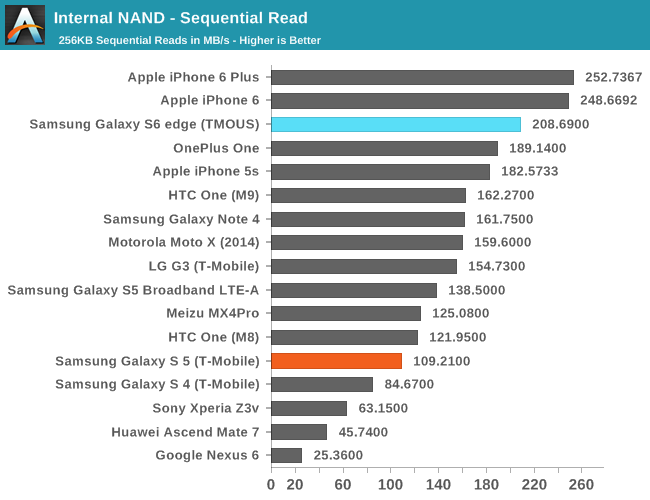
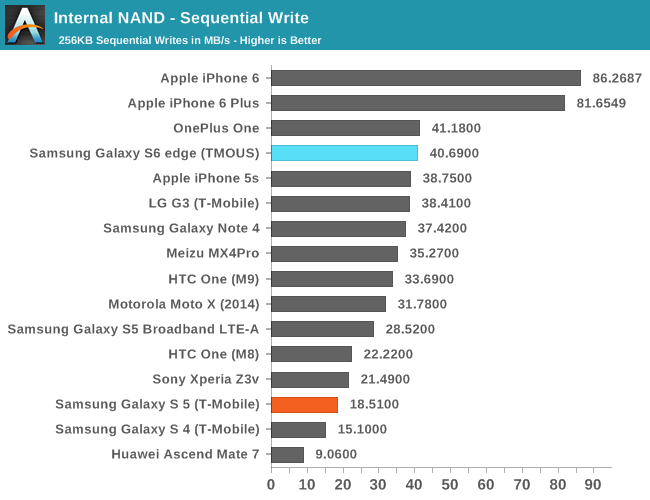
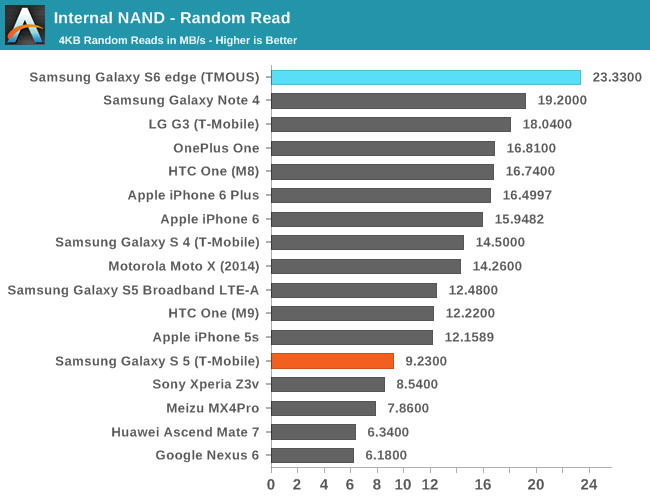
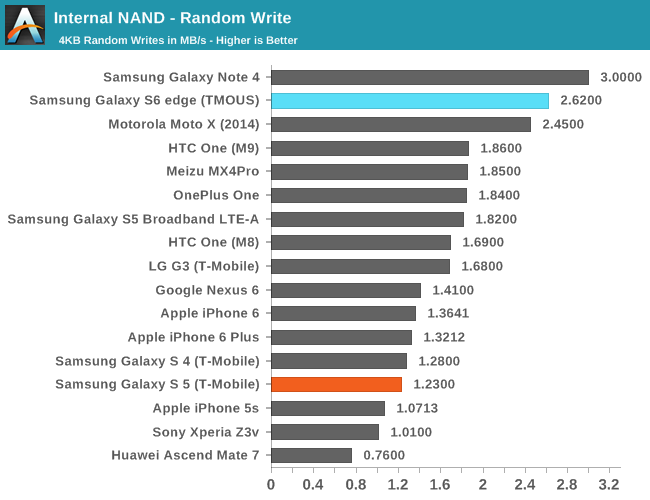
The Galaxy S6 performs rather impressively in our standard storage test, but not as fast as one might have hoped. This is due to the nature of the Androbench 3.6 test, which only tests a single IO thread, which won’t use the UFS storage of the Galaxy S6 to its full extent. In order to see the kind of difference that UFS really makes, I ran the same test again on Androbench 4.x, which does support multiple IO threads. However, as our iOS storage test and Androbench 3.6 don’t support more than a single IO thread we will continue to present both results for now.
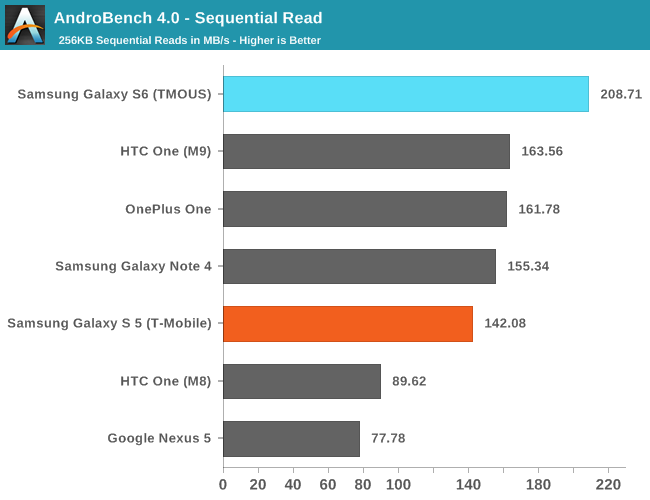
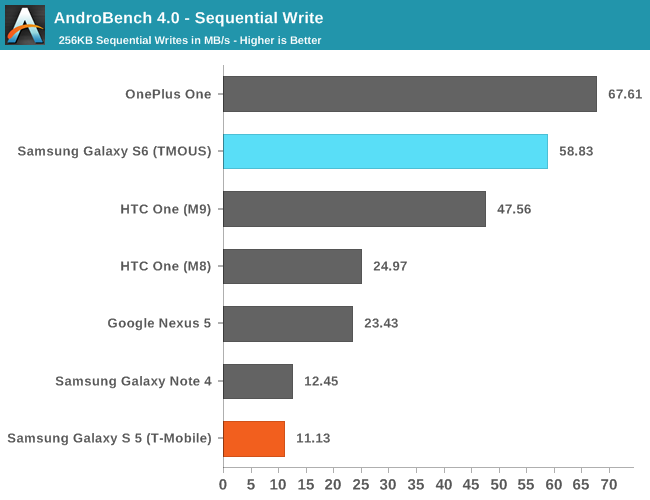
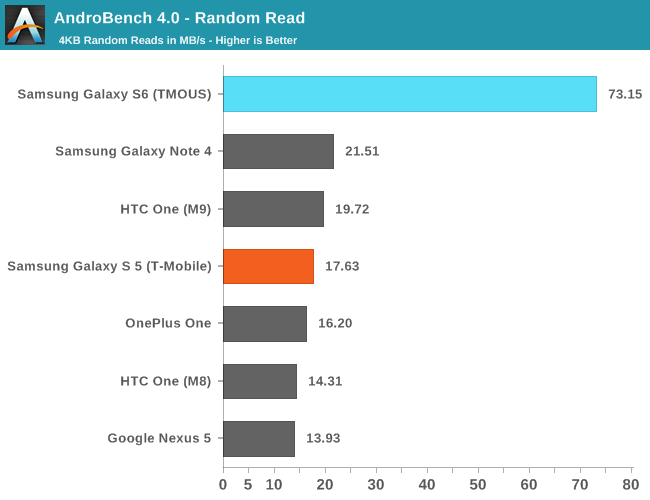
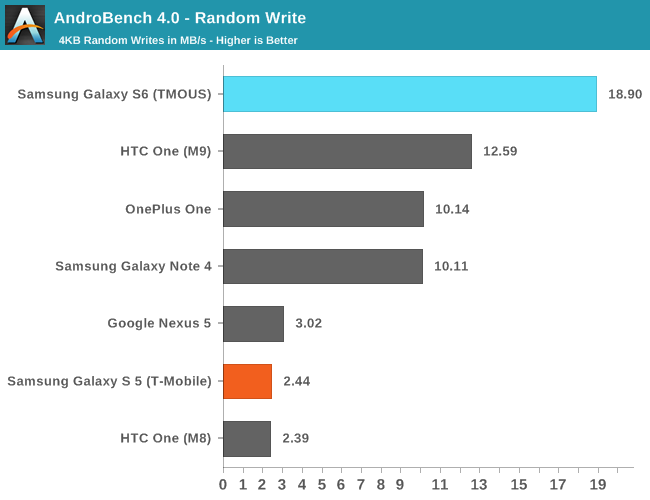
Overall, there are some immense benefits in storage performance here, especially in random IO performance. The Galaxy S6 has some of the fastest storage available in a phone today as far as I can tell given that this is basically a pure MLC solution, and shouldn’t have any real issue with storage performance holding back the rest of the phone over the course of 1-3 years as long as a reasonable amount of free space is kept to allow efficient storage management.


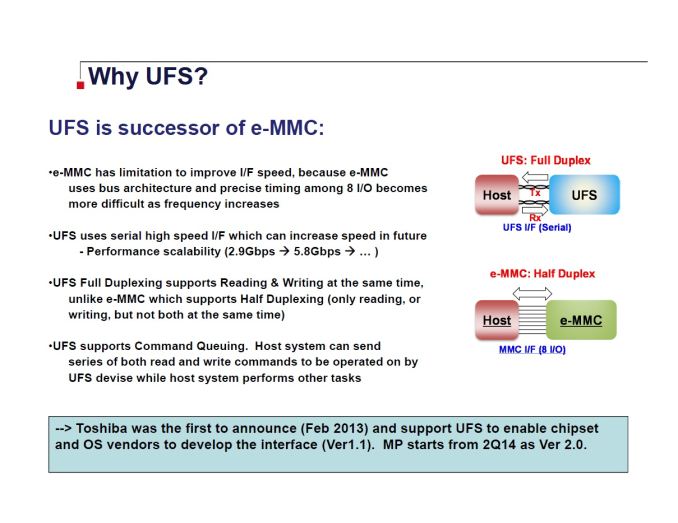








306 Comments
View All Comments
Drumsticks - Friday, April 17, 2015 - link
Thanks for the review! I've been waiting on the Anandtech review before looking at a new phone; y'alls simply can't be beat.The major concern for me with the S6 was battery life, but you seem to have put that concern to rest here. I fall under the "drawn by the new design" camp as well - I'm a pretty heavy user, but removable storage has never really mattered to me as I don't like keeping too much data on my phone. A removable battery is nice, but I'm already used to having a power pack with me so that's not a huge deal. I'm still waiting to see what the LG G4 brings though. If performance is good enough with the rumored SD 808 (really concerned about GPU driving the QuadHD Display), then the larger battery could make it worth it to go to LG. I'm also hoping that Samsung releases a custom theme tool, and somebody makes a relatively close stock Android icon/color set, as the default TouchWiz UI is kind of gaudy for me (teal? seriously?)
soccerballtux - Friday, April 17, 2015 - link
wow, I'm pretty impressed with the low-light performance of the camera.Novacius - Friday, April 17, 2015 - link
The first Android smartphone of recent dates that gets everything right imho. I'm considering buying it, but only when the price drops below 500 euros here.generalako - Friday, April 17, 2015 - link
I'm sorry, but I can't take Anandtech seriously anymore. I mean, just look at the the review of this phone's display. Somehow the iPhone 6 beats it in nearly every aspect, and there are key areas where the S6 is even worse than many other phones (like White Point). Compare this to DisplayMates shootout of the S6 (which is much more broad and of course has more legitimacy), who came to the conclusion that the S6 is the best phone display they have ever tested on almost every aspect. The same conclusion they had with the Note 4. Based on this review, however, the AMOLED on the S6 is still not better than the best LCD phone (iPhone 6).Let me give an example of how much these two tests vary, and how serious you should take Anandtech's test:
DisplayMate: "When Automatic Brightness is turned On, the Galaxy S6 reaches an impressive 784 cd/m2 (nits) "
Anandtech: Samsung Galaxy S6 reaches 610 nits.
That's a whole difference of 174 nits from the two tests!
Andrei Frumusanu - Friday, April 17, 2015 - link
DisplayMate derives that figure from a 1% APL pattern, which is pretty non-representative of any real-world use-case. The 610 nit figure here comes from a 100% APL image, meaning pure white. Also, if you read the bottom part of the display section, you will see the APL chart where we indeed show how brightness increases with lowering APL, reaching near the very figures that you are quoting.magreen - Friday, April 17, 2015 - link
You can't take Anandtech seriously because its data is (arguably) contradicted by one other review site's data?lesbaer45 - Friday, April 17, 2015 - link
As has been said repeatedly for a variety of reasons. No SD, not buying. No removable battery, not buying.I either hang on to the S5 until it dies or buy something else that meets my needs. Plain and simple.
Chaser - Friday, April 17, 2015 - link
Everyone has different phone usage preferences. I have no need for a 64-128GB SD card on top of the native storage. I have modest music stored and although I take a lot of photos I use One Drive's "camera roll" feature that immediately uploads new shots to my cloud when a usable wifi connection is made and they land on my PC in seconds.This removable battery/SD card "must have" mantra is getting old. I have absolutely no interest in carrying around an extra battery. Hopefully as native storage becomes more affordable and batteries even more efficient it will fade away forever.
Shadowmaster625 - Friday, April 17, 2015 - link
Its a shame they had to add all those wasted pixels. This phone would have much bettery performance and battery life at 1080p. I really dont get this need to drive so many pixels. The market needs to start penalizing this stupidity.Novacius - Friday, April 17, 2015 - link
I clearly see a difference because of the pentile matrix. For every green subpixel there are one bigger red and one blue subpixel. So the "effective resolution" is 1/3rd lower, which places the S5 at 288 dpi and the S6 at 384ppi respectively. Where I can see some sort of individual pixels or pentile "grain" on the S5's display, thats nearly impossible with the S6.